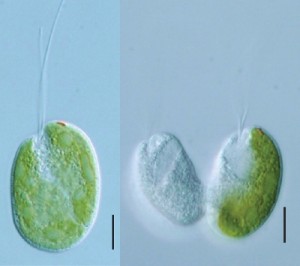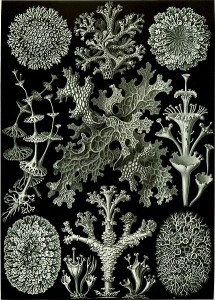From predator to plant in one gulp
The story of a predator that, upon eating a certain food, suddenly becomes a peaceful plant. Sort of.
Free-living versus symbiotic
A working definition for symbiosis is two or more species that live and interact. Mutualism means that each derives a certain benefit from the other, or at most causing no harm to each other. Their relationship is that of “give and take”. For example cleaning fish serve other fish by cleaning off parasites and getting protection, food and rides in return. Sometimes the mutualistic symbionts have practically fused into a single functional organism. The Portuguese Man o’ War is a colony of four different organisms which form a composite jellyfish; None of the individuals which can exist in a free-living form. Lichen is a colony of two: a photosynthetic partner providing sugars, and a fungus providing other nutrients as well as preventing the dehydration of the photosynthetic partner.
The Endosymbiotic Hypothesis
The endosymbiotic hypothesis maintains that eukaryotes evolved from symbiotic interactions between bacteria. There is plenty of evidence for that in chloroplasts and mitochondria: they have their own DNA; their membranes, their DNA, their ribosomes all resemble those of bacteria. The relationship between a eukaryotic cell and its mitochondria is heavily mutualistic: the cell gets ATP, the mitochondria / chloroplasts (M/C) get.. well, to live and reproduce, which they cannot do outside a living cell. Over time, M/C have have lost most of their genomic material to the host: many of the proteins needed to construct an M/C are not encoded in the M/C but in the host’s nucleus, and transported to the M/C. This is probably as intimately connected as two organisms can get, before you cannot tell that they were two separate organisms before they fused into an organism and an organelle. Indeed, the threshold set for distinguishing between an endosymbiont and an organelle lies in protein import. According to this working definition, once an endosymbiont starts importing proteins, it is no longer considered an endosymbiont and becomes an organelle. As with any working definition, if you scratch the surface a bit you will find cases where this rule does not apply well. Viruses are a case in point, acquiring host proteins and actually acting as a vector transferring them between hosts.
Vegging out
Two researchers have shown a striking example of endosymbiosis forming now: in 2005 Noriko Okamoto an Isao Inouye reported on a unicellular organism called Hatena. Hatena (“enigma” in Japanese) leads a curious life cycle. Hatena is a single-cell organism, swimming around in the water, using a little feeding apparatus to eat cells and organic material smaller than itself. At some point, it would feed on another unicellular algae, the Nephroselmis. Once Hatena swallows Nephroselmis, it does not digest it. Rather, Nephrosolmis makes itself comfortable home inside Hatena. The alga starts growing inside Hatena: it grows to about 10 times its original size, filling up most of Hatena. The alga also seems to lose most of its own organelles, except for the chloroplast. The chloroplast actually grows bigger.
Hatena changes too as a result. Before ingesting the alga, it has a rather complex “mouth”, or feeding apparatus. After ingesting the algae, this mouth disappears only to be replaced by an eyespot from the algae. The eyespot is a light sensing organelle, a very primitive eye, that guides algae to light sources. In this case, it also guides the host, Hatena, to light. Hatena has obviously stopped feeding, and least through its mouth. It is now swimming to the light, letting the alga photosynthesize its food for both of them.
I get the plant, you get the steakhouse coupons
Hatena reproduces by binary fission. So once it splits itself, what happens to the symbiotic alga? Well, one daughter cell gets the alga, and the other gets to be a predator… at least until it eats another alga. So here we are, looking at a fascinating evolutionary snapshot: two creatures, they can live apart or together. One is a predator,but is ready to be a plant under the right circumstances; the other is not quite an organelle of the first yet, but definitely on its way.

Right: Hatena with chloroplast, and without. Left: the red bit on the top of the cell marks the eyespot.
This article has been Slashdotted. Exercise extreme caution.
Okamoto, N. (2005). A Secondary Symbiosis in Progress? Science, 310 (5746), 287-287 DOI: 10.1126/science.1116125
OKAMOTO, N., & INOUYE, I. (2006). Hatena arenicola gen. et sp. nov., a Katablepharid Undergoing Probable Plastid Acquisition Protist, 157 (4), 401-419 DOI: 10.1016/j.protis.2006.05.011





















As a statin-affected (mitochondrial dysfunction) individual, I am interested in organelles and endosymbiosis. This was one of the most interesting write-ups I have seen on the subject. Thanks.
@John Brooks
Thanks. I find it humbling that someone so affected would take an interest in my blog. I heard about statins adversely affecting mitochondria. I hope a solution is found quickly.
@Iddo
If a solution is found, it will be found in the labs of higher education; Pharma won’t be involved, certainly. Beatrice Golomb (one of your own) and others at Harvard and NYU are trying to pin down the culprit(s) involved, and it looks like that may include genetic markers that predispose patients to the more serious side effects. FYI -I use a Google “ALERT” function which posts, to my email, internet activity based on keywords; MITOCHONDRIA brought you to my attention.
KILL IT WITH FIRE!!!!!
LOL slashdolt
but yeah good write up! thanks
nice article
Interesting stuff!
Thanks for the interesting article. I always find symbiots pretty interesting. This pair deferring different functions to become a new organism is pretty neat.
@John Brooks
Yes, it is quite interesting indeed, as if the ordinary world seems to get lost into the hidden logic without anny apparent reason.
I like that.
Great article, though I’m not statin-affected, and I did link to it from Slashdot. 🙂
Great article and thanks. Not to be a bio-jerk, but wouldn’t ‘peaceful protist’ be more fitting?
Hi, /.rs!
If you got this far, your next clue is pfiesteria piscicida. The article in Wikipedia is disputed because the pig farmers have bought their own studies because they are the triggers with their lakes of leaking pigsh*t.
@Porter
Hehehe… “peaceful protist” I’ll remember that. Much better!
got link to material from slashdot.
While i am not specifically into biology, i do find this kind of materials very fascinating. thank you 🙂
Great article.
Organismal biology seems to have been overshadowed by recreational genomics and transcriptionfactorology over the past ten years.
Nice to see something like this for a change.
Awesome!
Hey, it’s spore stage one! 😀
once an alga has been assimilated by a Hatena is is no longer able to reproduce? It strikes me that if it can not reproduce (with or without sex) then it is getting the shaft end of the deal.
@Peter Coates
I don’t know if that has been checked for this case. However, we do know that endosymbionts (e.g. mitochondria) do reproduce.